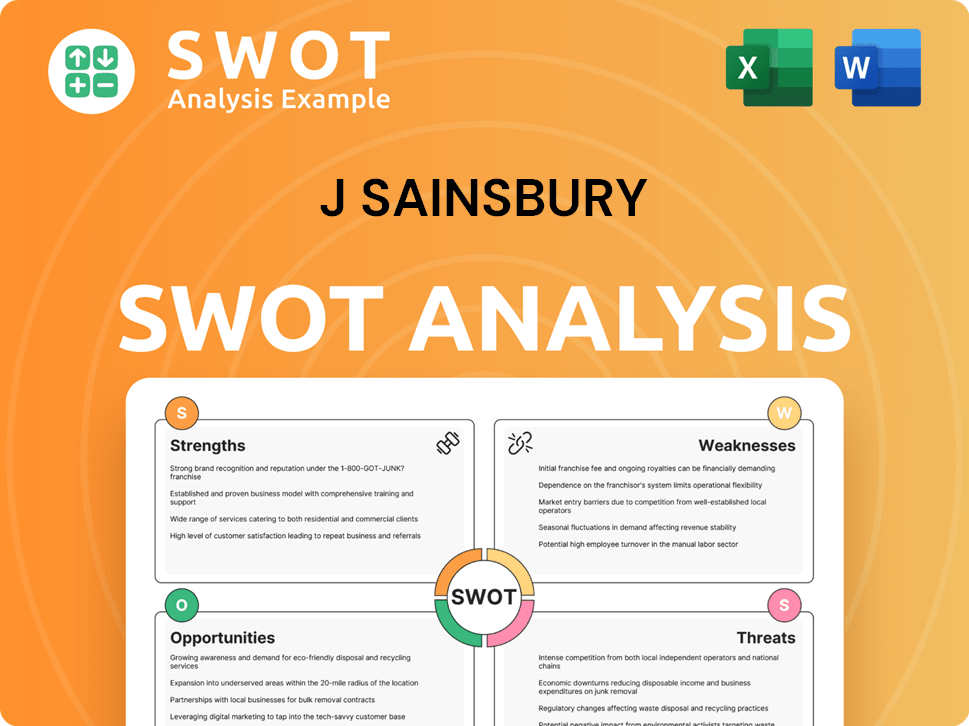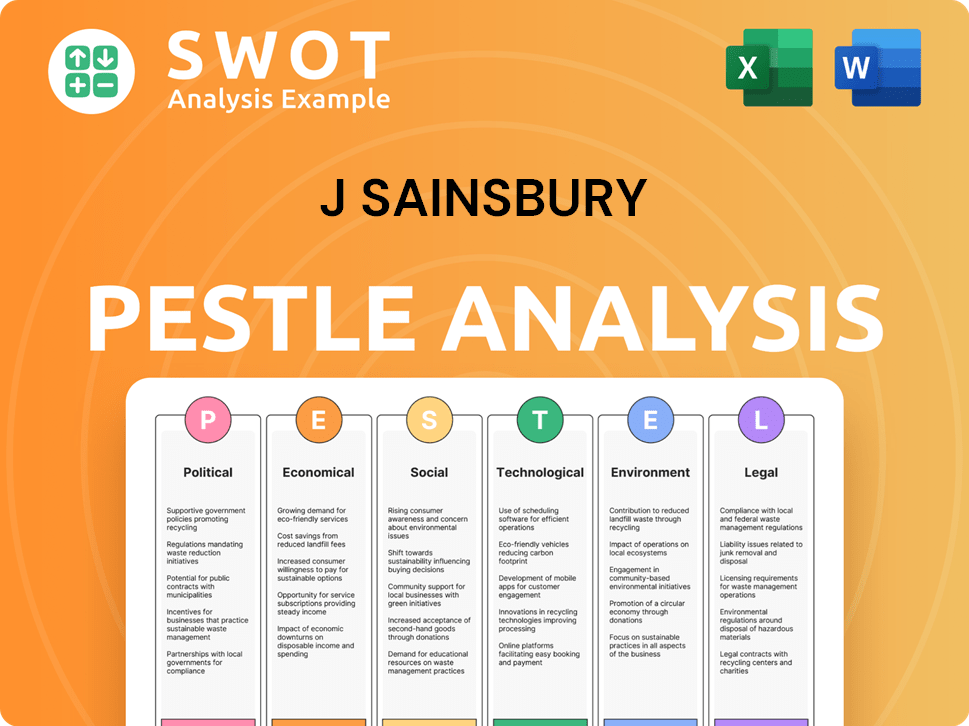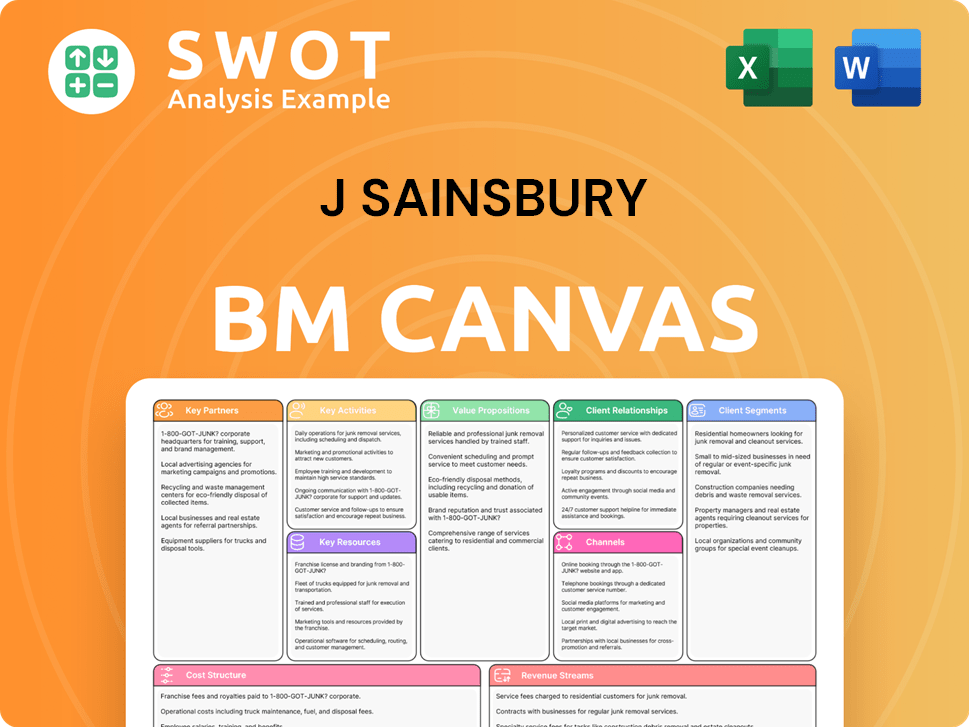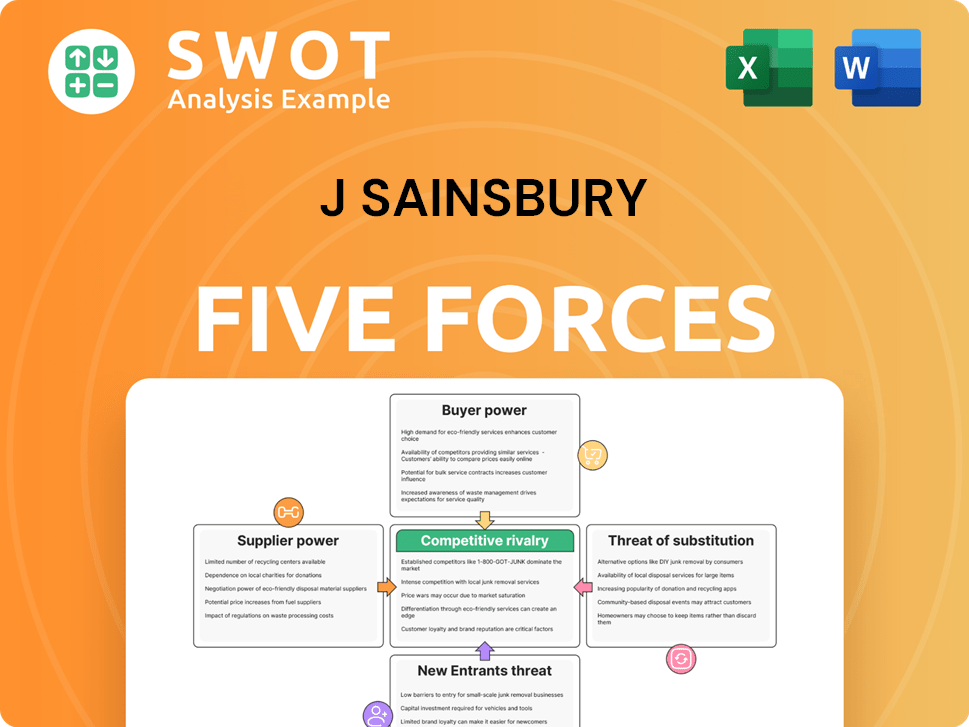J Sainsbury Bundle
Can Sainsbury's Sustain Its Growth in a Changing Retail World?
J Sainsbury, a cornerstone of the British retail scene, is constantly reshaping its approach to thrive in a dynamic market. Its 'Food First' strategy is a key element, focusing on its core grocery business and adapting to the evolving needs of consumers. This strategic shift is crucial for maintaining its competitive edge and navigating the challenges of the current economic climate.

From its humble beginnings in 1869, J Sainsbury SWOT Analysis reveals a history of adapting and expanding. This analysis will delve into Sainsbury's future prospects, examining its expansion plans, technological innovations, and financial strategies. Understanding the J Sainsbury growth strategy is key to assessing its long-term growth potential and investment opportunities within the grocery retail industry trends.
How Is J Sainsbury Expanding Its Reach?
The future growth strategy of J Sainsbury hinges significantly on its 'Food First' approach. This strategy prioritizes strengthening its core grocery business while strategically enhancing its non-food offerings. This focus is crucial for maintaining and growing its market share within the competitive grocery retail industry trends.
A key element of this strategy involves the ongoing optimization of its store estate. This includes opening new Sainsbury's Local convenience stores, and the strategic integration of Argos within its supermarkets. These initiatives are designed to improve accessibility and cater to evolving consumer preferences.
In the financial year 2023/24, the company continued to expand its convenience store network, demonstrating a commitment to increasing its footprint. This expansion is a vital part of the company's plan to capture a larger share of the local market and adapt to changing shopping habits. For a deeper understanding of the company's financial structure, consider exploring the Revenue Streams & Business Model of J Sainsbury.
Sainsbury's plans to open around 75 new convenience stores over the next three years. This expansion will help increase its presence in local markets. This initiative is a key part of the company's strategy to improve its market share.
The company is expanding its product ranges and services. This includes a focus on its 'Nectar Prices' loyalty program. It aims to provide personalized offers and value to customers.
Sainsbury's is investing in its online capabilities. This includes improving delivery services and expanding click-and-collect options. The goal is to capture a larger share of the e-commerce market.
The company explores partnerships to broaden its appeal. A successful example is its partnership with Just Eat for rapid grocery delivery. These collaborations are vital for reaching new customer segments.
Sainsbury's expansion plans in the UK are multifaceted, focusing on both physical and digital growth. The company is strategically positioning itself to meet evolving consumer demands and maintain a competitive edge in the market.
- Convenience Store Growth: Plans to open approximately 75 new convenience stores over the next three years.
- Digital Transformation: Enhancing online services, including delivery and click-and-collect.
- Customer Loyalty: Continued focus on the 'Nectar Prices' program to drive customer loyalty.
- Strategic Partnerships: Collaborations like Just Eat for rapid grocery delivery.
J Sainsbury SWOT Analysis
- Complete SWOT Breakdown
- Fully Customizable
- Editable in Excel & Word
- Professional Formatting
- Investor-Ready Format

How Does J Sainsbury Invest in Innovation?
Sainsbury's is actively leveraging innovation and technology to boost efficiency, improve customer experience, and ensure sustained growth. The company's digital transformation initiatives are central to its strategy, focusing on enhancing online platforms and streamlining supply chain operations. This approach is crucial for adapting to the evolving demands of the grocery retail industry and maintaining a competitive edge.
A significant portion of Sainsbury's investment is directed towards improving its e-commerce capabilities to meet the growing demand for online grocery shopping. This includes optimizing online platforms and expanding delivery services to enhance customer convenience. The company's focus on technology also extends to in-store innovations, such as electronic shelf labels and self-checkout systems, aimed at improving operational efficiency and freeing up staff to focus on customer service.
Furthermore, Sainsbury's is exploring cutting-edge technologies like artificial intelligence (AI) and data analytics to personalize customer offers through its Nectar loyalty program, optimize inventory management, and enhance supply chain resilience. The company's investment in data-driven insights allows it to better understand customer preferences and tailor its product offerings and marketing strategies. Sainsbury's also continues to invest in automation within its distribution centers to streamline operations and reduce costs.
Sainsbury's is heavily investing in digital transformation to improve online platforms and supply chain capabilities. This includes optimizing e-commerce operations to meet the growing demand for online grocery shopping. The company's focus on technology also extends to in-store innovations.
Sainsbury's is focusing on improving its e-commerce capabilities to meet the growing demand for online grocery shopping. This includes optimizing online platforms and expanding delivery services to enhance customer convenience. This is a key part of their J Sainsbury growth strategy.
The company is rolling out new technology solutions in its stores, such as electronic shelf labels and self-checkout systems. This improves operational efficiency and allows staff to focus on customer service, a key element of their Sainsbury's company analysis.
Sainsbury's is exploring AI and data analytics to personalize customer offers through its Nectar loyalty program. This also helps optimize inventory management and enhance supply chain resilience. This data-driven approach supports Sainsbury's future prospects.
The company is investing in automation within its distribution centers to streamline operations and reduce costs. This is a critical part of Sainsbury's supply chain optimization strategy. This is a key aspect of their operational efficiency.
Sustainability is a key part of Sainsbury's innovation strategy, with efforts to reduce environmental impact. This includes reducing plastic packaging and improving energy efficiency across its operations. This aligns with Sainsbury's sustainability initiatives.
Sainsbury's is focusing on digital transformation, e-commerce growth, in-store technology, AI and data analytics, supply chain optimization, and sustainability initiatives to drive growth and enhance customer experience. These efforts are crucial for maintaining Sainsbury's market share in the competitive grocery retail industry.
- Digital Transformation: Enhancing online platforms and supply chain capabilities.
- E-commerce Growth: Improving online platforms and expanding delivery services.
- In-Store Technology: Implementing electronic shelf labels and self-checkout systems.
- AI and Data Analytics: Personalizing customer offers and optimizing inventory.
- Supply Chain Optimization: Investing in automation within distribution centers.
- Sustainability Initiatives: Reducing plastic packaging and improving energy efficiency.
J Sainsbury PESTLE Analysis
- Covers All 6 PESTLE Categories
- No Research Needed – Save Hours of Work
- Built by Experts, Trusted by Consultants
- Instant Download, Ready to Use
- 100% Editable, Fully Customizable

What Is J Sainsbury’s Growth Forecast?
The financial outlook for J Sainsbury reflects a strategic focus on bolstering its core food business and improving operational efficiency. For the fiscal year ending March 2025, the company is expected to demonstrate continued resilience amidst economic challenges. Recent financial results show a strong performance, with underlying profit before tax reaching £701 million for the 52 weeks ending March 2, 2024, marking a 1.6% year-on-year increase. This performance underscores the effectiveness of the company's strategic initiatives and its ability to navigate the complexities of the grocery retail industry.
Sainsbury's financial strategy is rooted in its commitment to generating free cash flow and maintaining a robust balance sheet. The company's approach includes strategic investments and cost management to ensure sustainable financial health. This focus is critical in supporting the company's growth strategy and ensuring long-term value creation for shareholders. The company's financial performance is also influenced by its ability to adapt to changing consumer behaviors and market dynamics.
The company's financial health is further supported by a new share buyback program of £200 million for the 2024/25 financial year, demonstrating confidence in its financial position and commitment to shareholder returns. Analysts generally forecast stable revenue growth for Sainsbury's in the coming years, driven by its 'Food First' strategy and continued investment in its online and convenience channels. This strategic focus is essential for maintaining and increasing its market share in the competitive grocery retail industry. Understanding the Target Market of J Sainsbury is key to its financial success.
The company aims to achieve cumulative retail free cash flow of at least £1.6 billion over the three years leading up to March 2025. This target reflects Sainsbury's focus on generating strong cash flow to support its strategic initiatives and shareholder returns. The company’s financial ambitions are set against a backdrop of inflationary pressures and evolving consumer spending habits.
Analysts predict stable revenue growth for Sainsbury's, fueled by its 'Food First' strategy and ongoing investments in online and convenience channels. These investments are crucial for adapting to changing consumer preferences and maintaining a competitive edge in the market. The company's ability to innovate and respond to market trends will be essential for future growth.
The announcement of a £200 million share buyback program for the 2024/25 financial year signals confidence in Sainsbury's financial health and its dedication to shareholder returns. This strategy helps enhance shareholder value and reflects the company’s strong financial position. This commitment is a key element of Sainsbury's financial strategy.
Sainsbury's is focused on maintaining competitive pricing and enhancing its value proposition to customers amid inflationary pressures. The company's ability to manage costs and offer attractive prices is critical for retaining customers and driving sales. This approach is essential in a challenging economic environment.
The company's strategic initiatives are designed to maintain and potentially increase its market share in the competitive grocery retail industry. Sainsbury's market share is influenced by its ability to adapt to changing consumer behaviors and market dynamics. The company's focus on innovation and customer loyalty is critical.
Sainsbury's continues to focus on supply chain optimization to improve efficiency and reduce costs. Efficient supply chain management is crucial for maintaining profitability and ensuring product availability. The company's efforts to optimize its supply chain will support its long-term growth potential.
J Sainsbury Business Model Canvas
- Complete 9-Block Business Model Canvas
- Effortlessly Communicate Your Business Strategy
- Investor-Ready BMC Format
- 100% Editable and Customizable
- Clear and Structured Layout

What Risks Could Slow J Sainsbury’s Growth?
The growth strategy of J Sainsbury faces several risks and obstacles that could impact its future prospects. Intense competition within the UK grocery sector, particularly from discounters, poses a significant challenge. The company must navigate regulatory changes and potential supply chain disruptions to maintain profitability and customer satisfaction. This requires careful strategic planning and proactive risk management.
Regulatory changes, especially those related to food standards and environmental regulations, could increase operational costs. Supply chain vulnerabilities, intensified by global events, also present a substantial risk. Technological advancements and the rise of e-commerce further complicate the landscape, demanding continuous investment and adaptation. To understand more about their core values, you can read about the Mission, Vision & Core Values of J Sainsbury.
Internally, managing a large workforce and ensuring consistent service quality across its diverse operations also presents an ongoing challenge. Sainsbury's addresses these risks through comprehensive risk management frameworks, scenario planning, and continuous operational improvements, aiming to build resilience and adapt to emerging threats.
The UK grocery market is highly competitive, with discounters like Aldi and Lidl increasing their market share. This puts pressure on pricing and profit margins for Sainsbury's. Sainsbury's must differentiate itself through quality, service, and innovation to maintain its competitive position. This requires continuous strategic adjustments and investments.
Changes in regulations, such as those concerning HFSS (high fat, salt, and sugar) products, can affect product offerings and promotional strategies. Labor laws and environmental regulations also impact operational costs. Sainsbury's must adapt to these changes to remain compliant and competitive. This involves strategic planning and proactive adjustments.
Geopolitical tensions and climate change can disrupt the supply chain, leading to stock shortages and increased costs. Sainsbury's mitigates these risks through diversified sourcing and robust inventory management. Building strong supplier relationships is also crucial for resilience. This requires proactive supply chain management.
Rapidly evolving e-commerce trends and new entrants in the online grocery space pose a challenge. Sainsbury's must invest heavily in its digital infrastructure and online capabilities. This includes enhancing its online platform and delivery services. Adapting to digital transformation is key.
Managing a large workforce and ensuring consistent service quality across diverse operations is an ongoing challenge. Sainsbury's addresses this through comprehensive risk management frameworks and continuous operational improvements. Maintaining high service standards is essential for customer satisfaction. This requires consistent training and management.
Inflation and changes in consumer spending habits can impact Sainsbury's financial performance. Economic downturns may lead to reduced consumer spending and changes in purchasing behavior. Sainsbury's must adapt its pricing and product offerings to meet changing consumer needs. This requires close monitoring of economic indicators.
Sainsbury's market share in the UK grocery market is a key indicator of its competitive position. According to recent data, Sainsbury's holds a significant market share, but faces pressure from competitors. The company must focus on strategies to maintain and grow its market share. This includes customer loyalty programs and competitive pricing.
The grocery retail industry is subject to various trends, including the growth of online grocery sales and changing consumer preferences. Sainsbury's must adapt to these trends to remain competitive. This involves investing in digital transformation and offering innovative products. Sustainability initiatives are also becoming increasingly important.
J Sainsbury Porter's Five Forces Analysis
- Covers All 5 Competitive Forces in Detail
- Structured for Consultants, Students, and Founders
- 100% Editable in Microsoft Word & Excel
- Instant Digital Download – Use Immediately
- Compatible with Mac & PC – Fully Unlocked

Related Blogs
- What are Mission Vision & Core Values of J Sainsbury Company?
- What is Competitive Landscape of J Sainsbury Company?
- How Does J Sainsbury Company Work?
- What is Sales and Marketing Strategy of J Sainsbury Company?
- What is Brief History of J Sainsbury Company?
- Who Owns J Sainsbury Company?
- What is Customer Demographics and Target Market of J Sainsbury Company?
Disclaimer
All information, articles, and product details provided on this website are for general informational and educational purposes only. We do not claim any ownership over, nor do we intend to infringe upon, any trademarks, copyrights, logos, brand names, or other intellectual property mentioned or depicted on this site. Such intellectual property remains the property of its respective owners, and any references here are made solely for identification or informational purposes, without implying any affiliation, endorsement, or partnership.
We make no representations or warranties, express or implied, regarding the accuracy, completeness, or suitability of any content or products presented. Nothing on this website should be construed as legal, tax, investment, financial, medical, or other professional advice. In addition, no part of this site—including articles or product references—constitutes a solicitation, recommendation, endorsement, advertisement, or offer to buy or sell any securities, franchises, or other financial instruments, particularly in jurisdictions where such activity would be unlawful.
All content is of a general nature and may not address the specific circumstances of any individual or entity. It is not a substitute for professional advice or services. Any actions you take based on the information provided here are strictly at your own risk. You accept full responsibility for any decisions or outcomes arising from your use of this website and agree to release us from any liability in connection with your use of, or reliance upon, the content or products found herein.